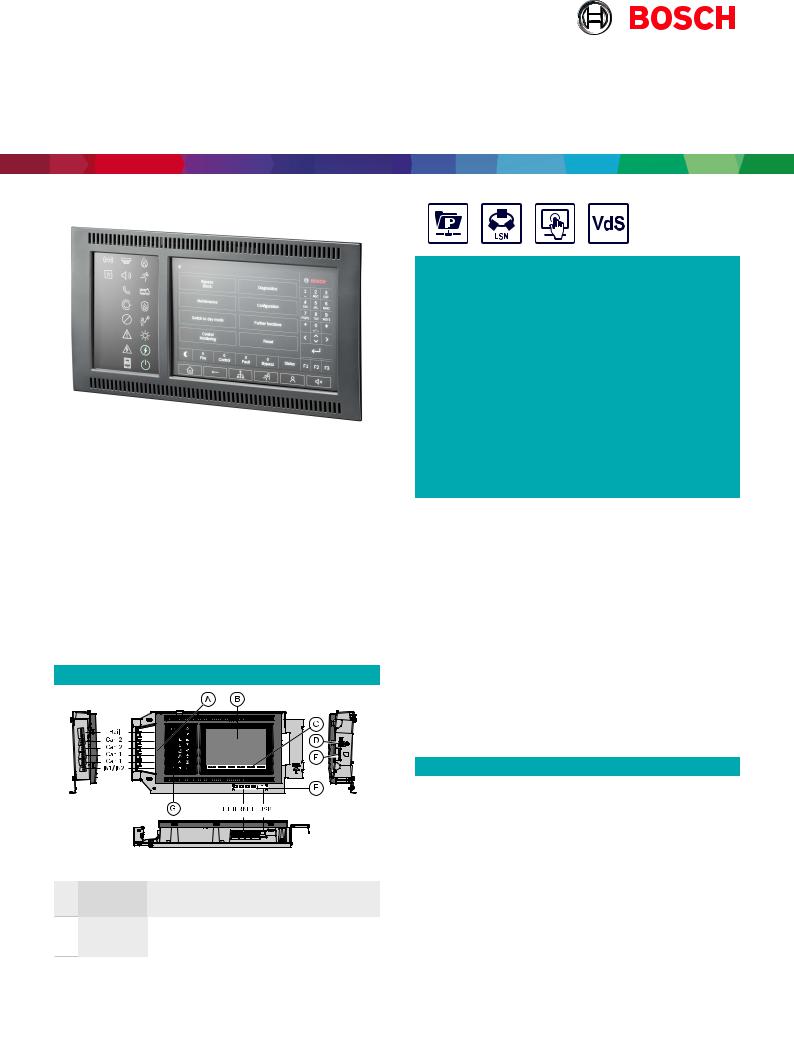Bosch FPE-8000-SPC, FPE-8000-PPC Datasheet

Fire Alarm Systems - Panel controller FPE-8000-SPC/PPC
Panel controller FPE-8000-SPC/PPC
The panel controller is the central component of the fire panel. All messages are shown on the color display. The entire system is operated via a touch screen. The user-friendly user interface adapts to various situations. This allows correct operation that is both simple and clear as well as targeted and intuitive.
The FSP-5000-RPS programming software enables adaption to projectand country-specific requirements.
System overview
Fig. 1: Overview of panel controller
Pos Designation Function
.
A |
Interfaces |
Panel networking and inputs for internal device |
monitoring
uHigh resolution display with bright colors to indicate alarms and events
u8" touch pad with fixed and programmable buttons, thus adaptable to the situation
uIntegrated Ethernet switch for networking and interfaces to remote services, building management and voice alarm systems
uAdaptable to local requirements and regulations
uUser interface and printed short user guide in 24 national languages
Pos |
Designation |
Function |
. |
|
|
B |
Touchscreen |
Operating the networked system through virtual |
|
|
buttons and variable display windows |
|
|
|
C |
6 fixed buttons |
Standard entries |
|
|
|
D |
Power button |
Shutdown and restart of the device |
|
|
|
E |
Memory card |
Memory card reader for maintenance services |
|
slot |
|
|
|
|
F |
Ethernet ports |
Panel networking and interface to various systems |
|
|
|
G |
18 LEDs |
Indicating the operating status |
|
|
|
Functions
Alarm indication
All messages are shown on the display with a bright color. The displayed messages contain the following information:
•Message type
•Type of the triggering element
•Description of the exact location of the triggering element
•Logical zone and sub-address of the triggering element

Fire Alarm Systems - Panel controller FPE-8000-SPC/PPC
18 Icon LEDs give continuous information about the operating status of the panel or the system. A red icon LED shows an alarm. A blinking yellow icon LED shows a fault. A steady yellow icon LED shows a disabled function. A green icon LED shows proper operation.
Two status LEDs, one red and one yellow, are programmable. The red one shows a self-defined alarm. The yellow one shows a self-defined fault or deactivation.
Additional annunciator modules, each with 16 red and 16 yellow LEDs are available to indicate a larger number of self-defined alarms, faults or deactivations.
Operation and processing of messages
For operating the panel, an 8 inch touch pad as input medium is put upon the display. There are 6 buttons with fixed functionality as well as 3 programmable function keys.
Examples for the assignment of the function keys:
•Set the panel controller to day mode, set the panel controller to night mode
•Enable detection points or outputs, disable detection points or outputs
•Set standard sensor sensitivity, set alternative sensor sensitivity
Each function key has a virtual status indicator.
At any time, an operator with sufficient user rights can control the function keys.
Overview of evacuation zones and outputs
At any time, the operator can get a clear overview of each evacuation zone and of each output connected to the fire protection equipment. Each zone and each output is marked with a programmable text label and a clearly distinctive color reflecting the state: Green shows idle state, power is available. Red shows an activation during fire alarm condition, and fuchsia an activation without a fire alarm condition. Yellow shows a fault or disabled state. An operator with sufficient user rights is able to start the evacuation in selected zones and activate outputs connected to the fire protection equipment through the user interface.
Saving and printing messages
The history log keeps incoming alarms and events internally. The history log has a capacity to store 10000 messages. The messages can be shown on the display, and you can export the messages. Additionally, you can connect a log printer via a serial interface module for real-time printing incoming messages.
Networking
Up to 32 panel controllers, remote keypads and OPC servers can be combined to form a network.
2 | 4
Panels and keypads display all messages, or you can form a group of panels and keypads. Within one group, only messages of this group are displayed.
A variety of fire alarm network topologies are possible:
•CAN loop
•Ethernet loop
•Ethernet/CAN double loop
•CAN loop with Ethernet segments
•Ethernet backbone with sub-loops (Ethernet/CAN)
Languages
The operator can change the language of the user interface. A printed quick user guide for each language is supplied with the package. Following languages are included: English, German, Bulgarian, Croatian, Czech, Danish, Dutch, Estonian, French, Greek, Hungarian, Italian, Latvian, Lithuanian, Polish, Portuguese, Romanian, Russian, Serbian, Slovak, Slovenian, Spanish, Swedish and Turkish.
Operator management
The system can have up to 200 different registered operators. Login is permitted with a user ID and an 8- digit pin code.
There are four different authorization levels. Depending on the authorization level it is possible for the operator to do certain functions according to EN54-2.
Interfaces
The panel controller features
•2 CAN interfaces (CAN1/CAN2) for networking
•1 Rail connector
•4 Ethernet interfaces (1 / 2 / 3 / 4) for networking, prescribed usage:
–1 and 2 (blue): Panel network
–3 (green): Building management system, hierarchy panel, voice alarm system
–4 (red): Remote Services
•2 signal inputs (IN1/IN2)
•1 USB function interface for configuration via FSP-5000-RPS
•1 Memory card interface
Licenses
The panel controller is delivered with a hard coded software license. This software license is implemented during production and cannot be modified, revoked or transported. The license defines the maximum panel network size and availability of certain features and interfaces.
